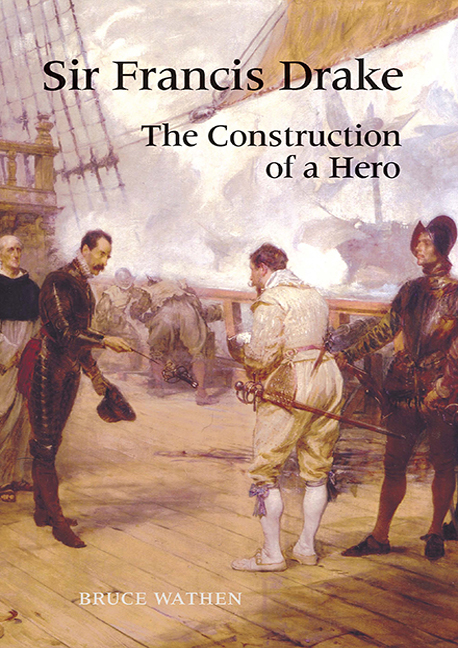Book contents
- Frontmatter
- Contents
- List of Illustrations
- Dedication
- Acknowledgements
- Introduction
- Chapter One Auxilio Divino
- Chapter Two ‘Sir Francis Drake Revived’
- Chapter Three ‘Behold the warrior dwindled to a beau’
- Chapter Four ‘Homage to Britannia’
- Chapter Five ‘Who the New World Bade British Thunders Shake?’
- Chapter Six ‘The Prose Epic of England’
- Chapter Seven ‘Mould him in bronze’
- Chapter Eight ‘Gun to Gun he'll Challenge us’
- Chapter Nine ‘A pirate, and a good one’
- Chapter Ten The Future
- Bibliography
- Index
Chapter Eight - ‘Gun to Gun he'll Challenge us’
Published online by Cambridge University Press: 11 May 2017
- Frontmatter
- Contents
- List of Illustrations
- Dedication
- Acknowledgements
- Introduction
- Chapter One Auxilio Divino
- Chapter Two ‘Sir Francis Drake Revived’
- Chapter Three ‘Behold the warrior dwindled to a beau’
- Chapter Four ‘Homage to Britannia’
- Chapter Five ‘Who the New World Bade British Thunders Shake?’
- Chapter Six ‘The Prose Epic of England’
- Chapter Seven ‘Mould him in bronze’
- Chapter Eight ‘Gun to Gun he'll Challenge us’
- Chapter Nine ‘A pirate, and a good one’
- Chapter Ten The Future
- Bibliography
- Index
Summary
See that ye hold fast the heritage we leave you.
(Louis Napoleon Parker, 1912)The construction of Sir Francis Drake that emerged in the period between the 1888 Armada tercentenary celebrations and the outbreak of the First World War clearly reflects the anxieties of a nation whose long economic and naval hegemony was facing serious challenges from both within and without Europe. In the previous chapter it was mentioned that the rapid spread of industrialization – particularly in Germany and the United States – led to a dramatic shortening of Britain's commercial and industrial lead over the rest of the world. Statistics expose this worrying trend. In 1880 Germany's share of world trade stood at 9.7 per cent but by 1898 this had steadily increased to 11.8 per cent. Meanwhile Britain's share had dropped significantly from 23.2 per cent in 1880 to 17.1 per cent in 1898. One consequence of industrial expansion was that rival powers were able to construct threateningly powerful navies. France, Russia and Japan as well as Germany and the United States embarked on large-scale shipbuilding programmes. Although no fleet could yet challenge the supremacy of the Royal Navy, agitation for increased naval expenditure commenced in the press and was rapidly taken up by organizations such as the Navy League, which was particularly vocal in its demands for rearmament. In the face of extensive foreign armament, the 1889 Naval Defence Act, which introduced the two-power standard – and which provided £21.5 million for new vessels including ten battleships – soon appeared inadequate. Finance for an additional seven battleships had been found by 1893.The issue of naval expenditure lay behind much of the Drake material produced during the first years of the century.
In 1890 Sir Julian Corbett published Sir Francis Drake, a robust and immensely readable life of the great seafarer. A novelist and war correspondent, Drake was Corbett's first attempt at an historical work. The biography was one volume in a series titled English Men of Action, which also included works on such exemplary figures as Henry V, Nelson and Wellington.
- Type
- Chapter
- Information
- Sir Francis DrakeThe Construction of a Hero, pp. 143 - 162Publisher: Boydell & BrewerPrint publication year: 2009

